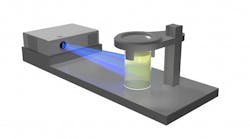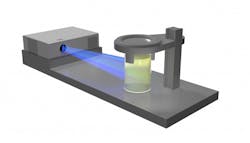In a recent project selected by NASA’s In Space Production Applications (InSPA) awards program, scientists and engineers are exploring how volumetric additive manufacturing (VAM) 3D printing technology can produce artificial cartilage tissue in space.
Project collaborators—Lawrence Livermore National Laboratory (LLNL) and Kentucky-based space life sciences company Space Tango—are using VAM 3D printing techniques for bioprinting cartilage in microgravity on the International Space Station (ISS).
The VAM technology takes computed tomography (CT) impressions of 3D objects from multiple angles before projecting the images into a photosensitive resin. The scientists explained that “the resin cures at points where the accumulated, absorbed light energy exceeds the gel thresholds.” Once the remaining liquid resin is drained, 3D objects emerge. This process happens within seconds or minutes, which makes it much faster than traditional layer-by-layer 3D printing techniques.
Mimicking the science fiction machine aboard the Starship Enterprise, the ultrafast 3D printer was playfully named “The Replicator” by co-developers LLNL and the University of California, Berkeley. The VAM printers are be expected to operate with little to no crew intervention, they reported.
LLNL principal investigator Maxim Shusteff pointed out that space-based manufacturing has been of interest for several years for the LLNL 3D printing community. He said support from Space Tango validates the promise the VAM technology shows and it connects the technology with the commercial spaceflight industry.
Space Tango has for several years been leveraging microgravity to improve the layer-by-layer deposition process. The R&D facility has conducted more than 200 automated microgravity experiments on the ISS since 2017.
Microgravity environments allow objects to appear to be weightless and enable scientists to better understand physical properties and processes, which ultimately improve design and modeling. Without gravity, shapes are more perfect.
As a platform for innovation, VAM technology is expected to perform well in zero or microgravity environments. In normal environments, VAM can cause “buoyant settling or convection of the resin,” noted the scientists. Eliminating gravity will create better-precision prints.
Shusteff said that tissue engineering with VAM could be one area where spaceborne production in microgravity may significantly benefit the outcome. “Cartilage tissue was chosen as a good balance of market need, impact to patients, technical feasibility and our available expertise,” he said.
What’s the Big Picture?
The InSPA awards support NASA’s plans to enable manufacturing “In Space for Earth” on the ISS; to develop new and promising technologies for advanced materials and products for use on Earth; and create a robust economy in low-Earth orbit.


